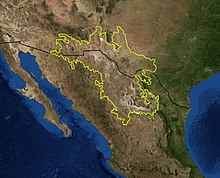Chihuahuan Desert Research Institute
The Chihuahuan Desert Research Institute ( CDRI ) is an independent, nonprofit, scientific, and educational organization based in the Davis Mountains foothills . It was founded in January 1974. The institute consists of a nature center with multi-purpose buildings and the botanical garden Chihuahuan Desert Nature Center and Botanical Gardens on an area of 507 acres (2.07 km²) south of Fort Davis in the US state Texas . The aim of the organization is to raise public awareness of the biodiversity of the Chihuahua Desert region and to stimulate appreciation and care for this ecoregion with the help of research and educational work. The founders were associated with Sul Ross State University , with which the institute works closely to this day. There is also close cooperation with numerous other schools, colleges, universities and other non-profit organizations in TEA Region 18 K-12 . Rick Herrman has been the Executive Director since 2015 . The institute has only a few permanent employees and works mainly with association members and volunteers.

history
From 1974 to 1983 the institute was housed in the Centennial School building in Alpine . The Alpine Independent School District leased the building generously to the CDRI for the symbolic sum of $ 1.00 per year.
In 1983 the Centennial School was sold and the CDRI was relocated to Honors Hall on the Sul Ross State University campus. There it held its events from 1983 to 1991, later it was housed in the Barton Warnock Science Building (1991-1997).
Education and Public Relations
The institute publishes a monthly newsletter via email, The Desert Newsflash . And at times the members took part in the radio program " Nature Notes " at KRTS , the station of the National Public Radio network in Marfa .
Land acquisitions
In 1978 and 1984 the institute acquired today's institute premises in two different but related transactions. The property was expanded with a multi-purpose building, which houses the Nature Center, and a botanical garden. Research and educational work is carried out there today. In January 1998 the new Visitors' Center was inaugurated and the institute relocated its work entirely from the Sul Ross campus. In August 2015, the Visitor Center was named the Powell Visitor Center in honor of its co-founder, Dr. Mike Powell , a recognized botanist and director of the SRSU Herbarium . Powell is still active at the CDRI with his wife Shirley. Another co-founder, James Scudday , was honored through the establishment of an Undergraduate Scholarship Fund for Sul Ross State University students (Scudday Scholarship Fund).
In order to expand the research spectrum, the Clayton's Overlook observation pavilion was built on the highest point of the site . It is named after co-founder Clayton Williams . From there, the geology of the desert can be explained particularly well. The pavilion allows a 360 ° panorama and explains the various terrain forms in the exhibition texts. In the immediate vicinity there are, for example, three igneous lava domes (with a diameter of 3–4 km), as well as other igneous land forms, including the volcanic subsoil on which the pavilion itself stands. It is assumed that these domes were formed as Lakkoliths . Their topography is variable and the removal of the cover rock is also quite different. In addition, the exhibition shows a large overview of the Davis Mountains. For example, the connection between the Crossen Trachyte , a geological unit in the south of the region, and the Star Mountain Formation , another geological unit in the north of the region, is shown.
financing
The CDRI is supported by entrance fees, funding programs, donations, annual membership fees, income from events, as well as loans and donations. Clayton Williams in particular has made great contributions and significant legacies come from the estate of Roger Conant (2005) and Kathryn J. Gloyd (2010), which has created permanent endowment capital that is administered by the Board Committee.
Individual evidence
- ↑ scudday-scholarship on the CDRI homepage.
- ^ Blaine R. Hall: Educational Platform: A Geological Pavilion to Take Advantage of a 360 ° Visual Experience. gsa.confex.com 2004.
Web links
- Chihuahuan Desert Research Institute
- Sibley Nature Center (Midland Texas) Essay on CDRI
- Lady Bird Johnson Wildflower Center at the University of Texas at Austin
- CDRI Geological Society of America grant proposal
Coordinates: 30 ° 33 '36 " N , 103 ° 50' 27.6" W.